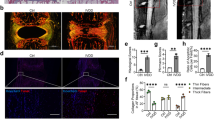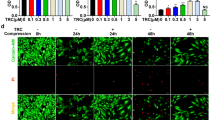Abstract
The expression of CHOP (C/EBP homologous protein), an apoptosis regulated gene, increases during endoplasmic reticulum (ER) stress induced by cyclic stretch and leads to rat AF cells apoptosis. However, whether the suppression of CHOP can inhibit apoptosis and attenuates disc degeneration by cyclic stretch remains unclear. The aim of this study was to evaluate the suppressive effects of lentiviral CHOP shRNA on apoptosis induced by cyclic stretch in rat annulus fibrosus (AF) cells in vitro and disc degeneration of rat lumber spine in vivo. Lentiviral CHOP shRNA was constructed and introduced into AF cells. After stretched by the Flexcell Tension Plus system with 20% elongation for 36 h, silencing of the CHOP gene was identified by RT-PCR and Western blot. Inhibition of apoptosis was detected by flow cytometry, and nuclei morphologic changes were visualized by Hoechst 33258 staining. The effect of CHOP shRNA on disc degeneration was determined in vivo by using a rat model. At 7 weeks after intradiscal injection of the control or CHOP shRNA in the L4/L5 and L5/L6 discs, disc degeneration was assessed by X-ray examination, magnetic resonance imaging (MRI) assessment, and HE and TUNEL staining. A significant decrease in CHOP mRNA and protein expression was detected in AF cells with CHOP shRNA transfection after 36 h stretch. There was a significant decrease in apoptotic incidence in cells treated with CHOP shRNA, which was parallel to the expression of CHOP. Injection of CHOP shRNA in vivo resulted in the improvement in MRI and histologic score, and decrease in the apoptosis in the disc. No significant change in disc height was observed. In conclusion, a novel lentiviral vector expressing CHOP shRNA efficiently inhibits apoptosis in rat AF cells by silencing CHOP expression. In a rat model, intradiscal injection of CHOP shRNA induces the suppression of disc degeneration. The therapeutic effects of lentiviral CHOP shRNA should be further explored.






Similar content being viewed by others
References
Gruber HE, Hanley EN Jr (1998) Analysis of aging and degeneration of the human intervertebral disc. Comparison of surgical specimens with normal controls. Spine 23:751–757
Ahsan R, Tajima N, Chosa E, Sugamata M, Sumida M, Hamada M (2001) Biochemical and morphological changes in herniated human intervertebral disc. J Orthop Sci 6:510–518
Park JB, Kim KW, Han CW, Chang H (2001) Expression of Fas receptor on disc cells in herniated lumbar disc tissue. Spine 26:142–146
Ariga K, Yonenobu K, Nakase T, Hosono N, Okuda S, Meng W et al (2003) Mechanical stress-induced apoptosis of endplate chondrocytes in organ-cultured mouse intervertebral discs: an ex vivo study. Spine 28:1528–1533
Court C, Colliou OK, Chin JR, Liebenberg E, Bradford DS, Lotz JC (2001) The effect of static in vivo bending on the murine intervertebral disc. Spine J 1:239–245
Lotz JC, Chin JR (2000) Intervertebral disc cell death is dependent on the magnitude and duration of spinal loading. Spine 25:1477–1483
Lotz JC, Colliou OK, Chin JR, Duncan NA, Liebenberg E (1998) Compression-induced degeneration of the intervertebral disc: an in vivo mouse model and finite-element study. Spine 23:2493–2506
Rannou F, Lee TS, Zhou RH, Chin J, Lotz JC, Mayoux-Benhamou MA et al (2004) Intervertebral disc degeneration: the role of the mitochondrial pathway in annulus fibrosus cell apoptosis induced by overload. Am J Pathol 164:915–924
Walsh AJ, Lotz JC (2004) Biological response of the intervertebral disc to dynamic loading. J Biomech 37:329–337
Park JB, Park IC, Park SJ, Jin HO, Lee JK, Riew KD (2006) Anti-apoptotic effects of caspase inhibitors on rat intervertebral disc cells. J Bone Joint Surg Am 88:771–779
Zhang YH, Zhao CQ, Jiang LS, Dai LY (2011) Cyclic stretch-induced apoptosis in rat annulus fibrosus cells is mediated in part by endoplasmic reticulum stress through nitric oxide production. Eur Spine J 2011 Feb 20 [Epub ahead of print]
Chen J, Qin J, Liu X, Han Y, Yang Z, Chang X et al (2008) Nitric oxide-mediated neuronal apoptosis in rats with recurrent febrile seizures through endoplasmic reticulum stress pathway. Neurosci Lett 443:134–139
Rodella LF, Ricci F, Borsani E, Stacchiotti A, Foglio E, Favero G et al (2008) Aluminium exposure induces Alzheimer’s disease-like histopathological alterations in mouse brain. Histol Histopathol 23:433–439
Wang HQ, Takahashi R (2007) Expanding insights on the involvement of endoplasmic reticulum stress in Parkinson’s disease. Antioxid Redox Signal 9:553–561
Kuhn K, D’Lima DD, Hashimoto S, Lotz M (2004) Cell death in cartilage. Osteoarthr Cartil 12:1–16
Oyadomari S, Mori M (2004) Roles of CHOP/GADD153 in endoplasmic reticulum stress. Cell Death Differ 11:381–389
Wang XZ, Lawson B, Brewer JW, Zinszner H, Sanjay A, Mi LJ et al (1996) Signals from the stressed endoplasmic reticulum induce C/EBP-homologous protein (CHOP/GADD153). Mol Cell Biol 16:4273–4280
McCullough KD, Martindale JL, Klotz LO, Aw TY, Holbrook NJ (2001) Gadd153 sensitizes cells to endoplasmic reticulum stress by down-regulating Bcl2 and perturbing the cellular redox state. Mol Cell Biol 21:1249–1259
Zinszner H, Kuroda M, Wang X, Batchvarova N, Lightfoot RT, Remotti H et al (1998) CHOP is implicated in programmed cell death in response to impaired function of the endoplasmic reticulum. Genes Dev 12:982–995
Cheng WP, Hung HF, Wang BW, Shyu KG (2008) The molecular regulation of GADD153 in apoptosis of cultured vascular smooth muscle cells by cyclic mechanical stretch. Cardiovasc Res 77:551–559
Rasmussen S, Krum-Moller DS, Lauridsen LR, Jensen SE, Mandoe H, Gerlif C et al (2008) Epidural steroid following discectomy for herniated lumbar disc reduces neurological impairment and enhances recovery: a randomized study with two-year follow-up. Spine 33:2028–2033
Olah M, Molnar L, Dobai J, Olah C, Feher J, Bender T (2008) The effects of weightbath traction hydrotherapy as a component of complex physical therapy in disorders of the cervical and lumbar spine: a controlled pilot study with follow-up. Rheumatol Int 28:749–756
Pomerantz SR, Hirsch JA (2006) Intradiscal therapies for discogenic pain. Semin Musculoskelet Radiol 10:125–135
Zhang Y, An HS, Tannoury C, Thonar EJ, Freedman MK, Anderson DG (2008) Biological treatment for degenerative disc disease: implications for the field of physical medicine and rehabilitation. Am J Phys Med Rehabil 87:694–702
Nishida K, Kang JD, Gilbertson LG, Moon SH, Suh JK, Vogt MT et al (1999) Modulation of the biologic activity of the rabbit intervertebral disc by gene therapy: an in vivo study of adenovirus-mediated transfer of the human transforming growth factor beta 1 encoding gene. Spine 24:2419–2425
Paul R, Haydon RC, Cheng H, Ishikawa A, Nenadovich N, Jiang W et al (2003) Potential use of Sox9 gene therapy for intervertebral degenerative disc disease. Spine 28:755–763
Yoon ST, Park JS, Kim KS, Li J, Attallah-Wasif ES, Hutton WC et al (2004) LMP-1 upregulates intervertebral disc cell production of proteoglycans and BMPs in vitro and in vivo. Spine 29:2603–2611
Wallach CJ, Sobajima S, Watanabe Y, Kim JS, Georgescu HI, Robbins P et al (2003) Gene transfer of the catabolic inhibitor TIMP-1 increases measured proteoglycans in cells from degenerated human intervertebral discs. Spine 28:2331–2337
Le Maitre CL, Hoyland JA, Freemont AJ (2007) Interleukin-1 receptor antagonist delivered directly and by gene therapy inhibits matrix degradation in the intact degenerate human intervertebral disc: an in situ zymographic and gene therapy study. Arthritis Res Ther 9:R83
Nishida K, Suzuki T, Kakutani K, Yurube T, Maeno K, Kurosaka M et al (2008) Gene therapy approach for disc degeneration and associated spinal disorders. Eur Spine J 17(Suppl 4):459–466
Fu HY, Minamino T, Tsukamoto O, Sawada T, Asai M, Kato H et al (2008) Overexpression of endoplasmic reticulum-resident chaperone attenuates cardiomyocyte death induced by proteasome inhibition. Cardiovasc Res 79:600–610
Brummelkamp TR, Bernards R, Agami R (2002) A system for stable expression of short interfering RNAs in mammalian cells. Science 296:550–553
Rubinson DA, Dillon CP, Kwiatkowski AV, Sievers C, Yang L, Kopinja J et al (2003) A lentivirus-based system to functionally silence genes in primary mammalian cells, stem cells and transgenic mice by RNA interference. Nat Genet 33:401–406
Rannou F, Poiraudeau S, Foltz V, Boiteux M, Corvol M, Revel M (2000) Monolayer anulus fibrosus cell cultures in a mechanically active environment: local culture condition adaptations and cell phenotype study. J Lab Clin Med 136:412–421
Wang YJ, Shi Q, Lu WW, Cheung KC, Darowish M, Li TF et al (2006) Cervical intervertebral disc degeneration induced by unbalanced dynamic and static forces: a novel in vivo rat model. Spine 31:1532–1538
Rousseau MA, Bass EC, Lotz JC (2004) Ventral approach to the lumbar spine of the Sprague–Dawley rat. Lab Anim (NY) 33:43–45
Nishida K, Doita M, Takada T, Kakutani K, Miyamoto H, Shimomura T et al (2006) Sustained transgene expression in intervertebral disc cells in vivo mediated by microbubble-enhanced ultrasound gene therapy. Spine 31:1415–1419
Masuda K, Aota Y, Muehleman C, Imai Y, Okuma M, Thonar EJ et al (2005) A novel rabbit model of mild, reproducible disc degeneration by an anulus needle puncture: correlation between the degree of disc injury and radiological and histological appearances of disc degeneration. Spine 30:5–14
Nishimura K, Mochida J (1998) Percutaneous reinsertion of the nucleus pulposus. An experimental study. Spine 23:1531–1539
Zhao CQ, Zhang YH, Jiang SD, Jiang LS, Dai LY (2010) Both endoplasmic reticulum and mitochondria are involved in disc cell apoptosis and intervertebral disc degeneration in rats. Age 32:161–177
Oyadomari S, Takeda K, Takiguchi M, Gotoh T, Matsumoto M, Wada I et al (2001) Nitric oxide-induced apoptosis in pancreatic beta cells is mediated by the endoplasmic reticulum stress pathway. Proc Natl Acad Sci USA 98:10845–10850
Seki S, Asanuma-Abe Y, Masuda K, Kawaguchi Y, Asanuma K, Muehleman C et al (2009) Effect of small interference RNA (siRNA) for ADAMTS5 on intervertebral disc degeneration in the rabbit anular needle-puncture model. Arthritis Res Ther 11:R166
Manjunath N, Wu H, Subramanya S, Shankar P (2009) Lentiviral delivery of short hairpin RNAs. Adv Drug Deliv Rev 61:732–745
Masuda K, Imai Y, Okuma M, Muehleman C, Nakagawa K, Akeda K et al (2006) Osteogenic protein-1 injection into a degenerated disc induces the restoration of disc height and structural changes in the rabbit anular puncture model. Spine 31:742–754
Du W, Jiang P, Li N, Mei Y, Wang X, Wen L et al (2009) Suppression of p53 activity by Siva1. Cell Death Differ 16:1493–1504
Lois C, Hong EJ, Pease S, Brown EJ, Baltimore D (2002) Germline transmission and tissue-specific expression of transgenes delivered by lentiviral vectors. Science 295:868–872
Lai Z, Brady RO (2002) Gene transfer into the central nervous system in vivo using a recombinant lentivirus vector. J Neurosci Res 67:363–371
Sapru MK, Yates JW, Hogan S, Jiang L, Halter J, Bohn MC (2006) Silencing of human alpha-synuclein in vitro and in rat brain using lentiviral-mediated RNAi. Exp Neurol 198:382–390
Alini M, Eisenstein SM, Ito K, Little C, Kettler AA, Masuda K et al (2008) Are animal models useful for studying human disc disorders/degeneration? Eur Spine J 17:2–19
Moon SH, Nishida K, Gilbertson LG, Lee HM, Kim H, Hall RA et al (2008) Biologic response of human intervertebral disc cells to gene therapy cocktail. Spine 33:1850–1855
Acknowledgments
This study was supported by the National Natural Science Foundation of China (U1032001, 81000793, 81071500) and Science and Technology Commission of Shanghai Municipality (09411953000).
Conflict of interest
None.
Author information
Authors and Affiliations
Corresponding author
Additional information
Yue-Hui Zhang and Chang-Qing Zhao contribute equally to this study.
Rights and permissions
About this article
Cite this article
Zhang, YH., Zhao, CQ., Jiang, LS. et al. Lentiviral shRNA silencing of CHOP inhibits apoptosis induced by cyclic stretch in rat annular cells and attenuates disc degeneration in the rats. Apoptosis 16, 594–605 (2011). https://doi.org/10.1007/s10495-011-0596-y
Published:
Issue Date:
DOI: https://doi.org/10.1007/s10495-011-0596-y




